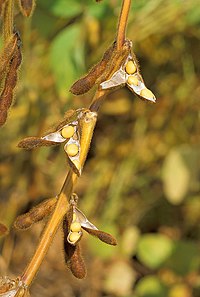
Photo from wikipedia
Purpose To assess the association between the consumption of non-soy legumes and different subtypes of non-soy legumes and serum uric acid (SUA) or hyperuricemia in elderly individuals with overweight or… Click to show full abstract
Purpose To assess the association between the consumption of non-soy legumes and different subtypes of non-soy legumes and serum uric acid (SUA) or hyperuricemia in elderly individuals with overweight or obesity and metabolic syndrome. Methods A cross-sectional analysis was conducted in the framework of the PREDIMED-Plus study. We included 6329 participants with information on non-soy legume consumption and SUA levels. Non-soy legume consumption was estimated using a semi-quantitative food frequency questionnaire. Linear regression models and Cox regression models were used to assess the associations between tertiles of non-soy legume consumption, different subtypes of non-soy legume consumption and SUA levels or hyperuricemia prevalence, respectively. Results Individuals in the highest tertile (T3) of total non-soy legume, lentil and pea consumption, had 0.14 mg/dL, 0.19 mg/dL and 0.12 mg/dL lower SUA levels, respectively, compared to those in the lowest tertile (T1), which was considered the reference one. Chickpea and dry bean consumption showed no association. In multivariable models, participants located in the top tertile of total non-soy legumes [prevalence ratio (PR): 0.89; 95% CI 0.82–0.97; p trend = 0.01, lentils (PR: 0.89; 95% CI 0.82–0.97; p trend = 0.01), dry beans (PR: 0.91; 95% C: 0.84–0.99; p trend = 0.03) and peas (PR: 0.89; 95% CI 0.82–0.97; p trend = 0.01)] presented a lower prevalence of hyperuricemia (vs. the bottom tertile). Chickpea consumption was not associated with hyperuricemia prevalence. Conclusions In this study of elderly subjects with metabolic syndrome, we observed that despite being a purine-rich food, non-soy legumes were inversely associated with SUA levels and hyperuricemia prevalence. Trial registration ISRCTN89898870. Registration date: 24 July 2014.
Journal Title: European Journal of Nutrition
Year Published: 2019
Link to full text (if available)
Share on Social Media: Sign Up to like & get
recommendations!